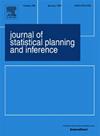相关截断数据下的加速失效时间模型
IF 0.8
4区 数学
Q3 STATISTICS & PROBABILITY
引用次数: 0
摘要
本文在相关截断数据框架下深入研究加速失效时间模型,并利用copula模型建立数据集内部的相关性。Chaieb等人(2006)利用copula-graph方法估计生存函数,并提出了一种估计相关参数的方法。在此基础上,我们通过引入两种不同的回归参数估计技术,进一步扩展了该方法。第一种方法是通过计算生存曲线之间的面积来评估参数,第二种方法是利用生存跳权结合最小二乘法来估计回归参数。我们通过模拟研究来评估这些建议的估计程序的有效性,并在两种方法之间进行比较分析。此外,我们将这些方法应用于两个真实世界的数据集,提供了对其实际适用性的见解。通过此分析,我们可以更深入地了解如何在实际场景中有效地利用这些方法。本文章由计算机程序翻译,如有差异,请以英文原文为准。
Accelerated failure time model under dependent truncated data
This paper delves into the accelerated failure time model within the framework of dependent truncation data and leverages the copula model to establish correlations within the dataset. Building upon the work of Chaieb et al. (2006), who utilized the copula-graphic method to estimate survival functions and proposed an approach for estimating correlation parameters, we further extend the methodology by introducing two distinct estimation techniques for regression parameters. The first method involves parameter evaluation through the calculation of the area between survival curves, while the second method employs the weight of survival jump in conjunction with the least squares approach to estimate regression parameters. We evaluate the efficacy of these proposed estimation procedures through simulation studies and conduct a comparative analysis between the two approaches. Furthermore, we apply these methodologies to two real-world datasets, providing insights into their practical applicability. Through this analysis, we gain a deeper understanding of how these approaches can be effectively utilized in real-world scenarios.
求助全文
通过发布文献求助,成功后即可免费获取论文全文。
去求助
来源期刊
CiteScore
2.10
自引率
11.10%
发文量
78
审稿时长
3-6 weeks
期刊介绍:
The Journal of Statistical Planning and Inference offers itself as a multifaceted and all-inclusive bridge between classical aspects of statistics and probability, and the emerging interdisciplinary aspects that have a potential of revolutionizing the subject. While we maintain our traditional strength in statistical inference, design, classical probability, and large sample methods, we also have a far more inclusive and broadened scope to keep up with the new problems that confront us as statisticians, mathematicians, and scientists.
We publish high quality articles in all branches of statistics, probability, discrete mathematics, machine learning, and bioinformatics. We also especially welcome well written and up to date review articles on fundamental themes of statistics, probability, machine learning, and general biostatistics. Thoughtful letters to the editors, interesting problems in need of a solution, and short notes carrying an element of elegance or beauty are equally welcome.

 求助内容:
求助内容: 应助结果提醒方式:
应助结果提醒方式:


